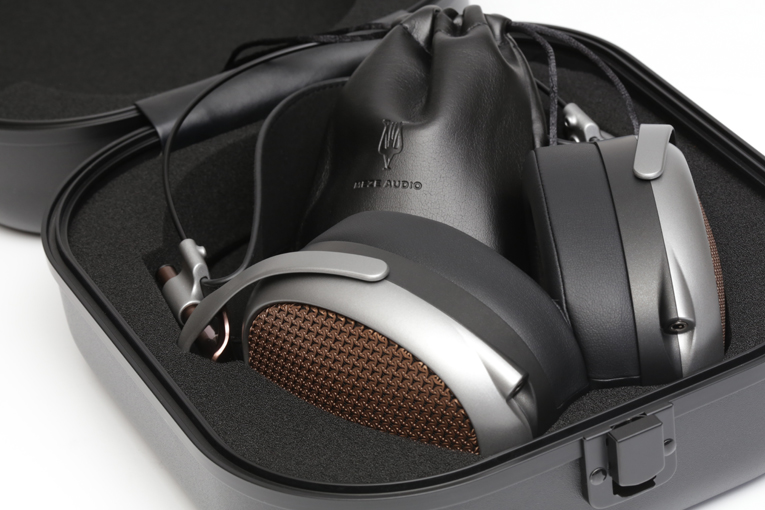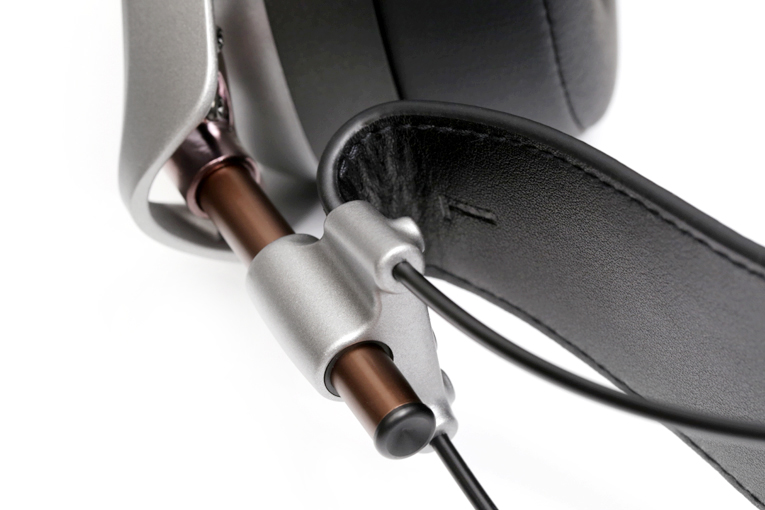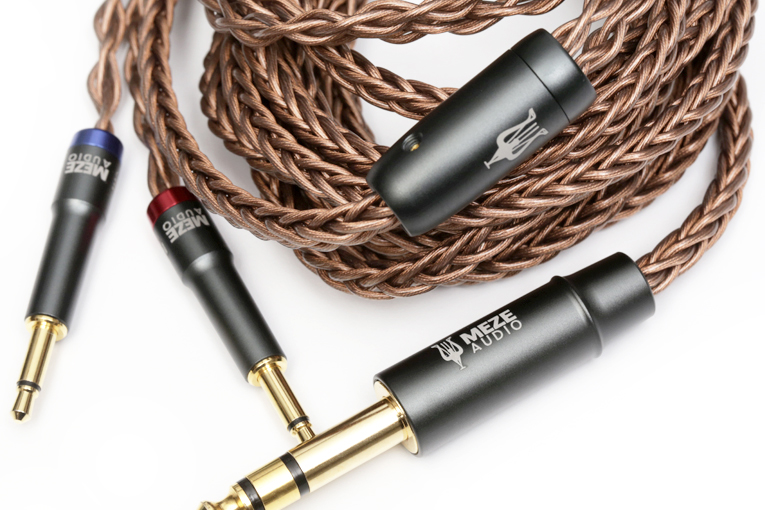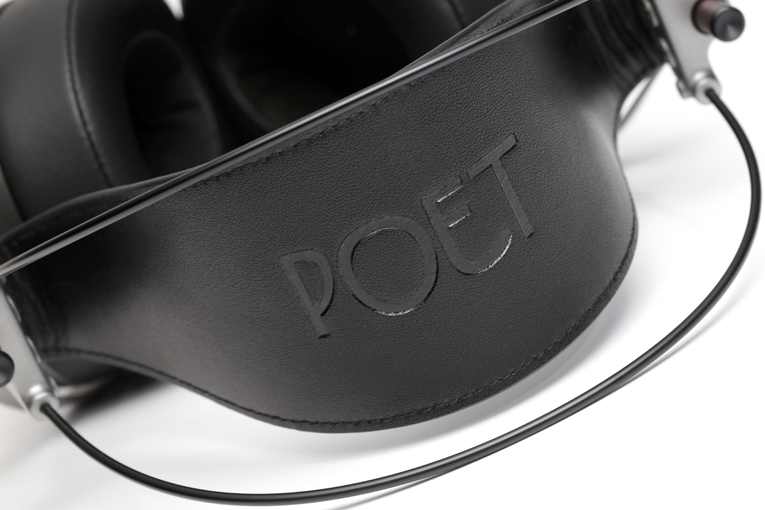Sound: 









Value: 









(Read about our ratings)
 I’m generally skeptical of headphones with four-figure price tags. Meze Audio’s open-back Poet headphones cost US$2000, CA$2799, £1899, or €2000, but it’s a well-established fact that sound quality does not correlate with price. And no matter how fancy the appearance of a pair of headphones, you can’t actually see them in use, unless you plan to listen in front of a mirror! But then again, you don’t get to appreciate the exterior styling of a sports car while you’re driving it, either.
I’m generally skeptical of headphones with four-figure price tags. Meze Audio’s open-back Poet headphones cost US$2000, CA$2799, £1899, or €2000, but it’s a well-established fact that sound quality does not correlate with price. And no matter how fancy the appearance of a pair of headphones, you can’t actually see them in use, unless you plan to listen in front of a mirror! But then again, you don’t get to appreciate the exterior styling of a sports car while you’re driving it, either.
Meze’s Poet headphones definitely look like they belong in four-figure territory. This is one of many subjective aspects of a headphone review, but the Poets are quite stunning, with a sort of steampunk-inspired aesthetic combining matte gunmetal (magnesium) with warm copper tones and black leather. Both the look and feel of these headphones are beautifully engineered.

What helps justify the price further, however, is that these aren’t just some regular old dynamic drivers, dressed-up all fancy. The Poet headphones combine high-performance materials and genuinely advanced technologies, which I will get into shortly. They feature a relatively compact design similar to Meze’s Liric ’phones, with a suspension headband and a lightweight magnesium chassis for durability and comfort.
Let’s dig into the tech that Meze has incorporated here. The headphones are equipped with Isodynamic Hybrid Array technology, developed exclusively for Meze Audio by Rinaro Isodynamics. These are cutting-edge transducers. Each MZ6 driver is hand-assembled and tested at Rinaro’s facility in Ukraine. The Parus diaphragm used in the drivers is made from a biaxially oriented, semi-crystalline polymer film, with an active area of 3507mm², yet an exceptionally low weight of 0.06g. It’s similar to what’s used in Meze’s flagship Elite and Empyrean II headphones. Neodymium magnets are symmetrically placed on either side of the diaphragm, arranged in what Rinaro calls a Hybrid Array, which is said to create a uniform 0.3 Tesla isodynamic magnetic field across the diaphragm’s entire surface.

The headphones also employ Dan Clark Audio’s Acoustic Metamaterial Tuning System (AMTS), used under license. Dan Clark himself describes AMTS as a system that uses metamaterials (those not found in nature, but engineered to exhibit specific properties) to create a programmable array of dual-function waveguides. The waveguides reorient the sound waves to change soundstage perception, so it’s more like the sound is coming from in front of the listener.
When configured, these structures act as waveguides and quarter-wave or Helmholtz resonators. This helps eliminate the standing waves and resonances that naturally occur within each earcup. Just like in a room, there are resonant modes (standing waves) and reflections off walls that occur at very high frequencies in headphones. By using quarter-wave resonators, these high-frequency issues can be precisely controlled by applying damping or notches at specific frequencies. The metamaterials are effectively tuned to eliminate peaks and dips in the response. In sum, this technology promises to smooth out harsh high frequencies and expand the soundstage.
In the box
The headphones come nestled inside a black, hinged hard-shell case, whose footprint is shaped like a rounded rectangle. The case has a latch to keep it securely closed, though the top and bottom feel a bit flimsier than their appearance would suggest. Not a concern, as the case should protect the headphones in most situations. While it certainly wouldn’t qualify as a flight case, it takes inspiration from one, with the inside lined with black, open-cell foam with a cutout that accommodates the headphones (with the cable removed) perfectly.

The cable is kept separately in a smart, black leather pouch, which closes with a drawstring and is embossed with the Meze Audio logo. The neatly braided cable appears substantial, by virtue of both the build quality and the 2.5m (8′ 2″) length. It looks quite striking, with the dense, woven-copper conductors perfectly complementing the perforated copper mesh used on the backs of the earcups.
Use
The Poet ’phones weigh 405g (without the cable), making them one of the lighter full-size options in Meze’s lineup. There’s clearly been some effort to reduce weight—the choice of magnesium for the chassis, and the slim wire-frame used across the headband—but they’re still pretty hefty compared to a typical pair of circumaural headphones.
I did notice, though, that the wire-frame structure that connects the left and right earcups has an undamped resonance you’ll hear quite clearly if you happen to tap anywhere on the headphones while you’re wearing them. This produces a ringing “boing” sound, with a fundamental frequency of 86Hz. Fortunately, the drivers seem well enough isolated from the structure that I wasn’t able to excite this resonance with any of the review material I played over the headphones.

Size adjustments are made with high-friction sliding rods that support the yokes on either side; these also allow the earcups to fully rotate and swivel vertically. This is a well-designed system that means the headphones fit a wide range of head sizes with ease. The 80mm × 50mm (3.2″ × 2.0″) ovoid openings in the magnetically attached earpads were comfortably snug around my ears and the fit was secure. In combination, these design features kept the earpads firmly pressed around my ears and prevented the slipping and sliding around I experienced with the first-generation Meze Empyreans.
When connected to the sockets on the bottom of each earcup, the metal bodies of the two TS jack connectors protrude at an angle down and forward, which is the most obvious cue as to which way to put them on, since otherwise the headphones are symmetrical when viewed in profile. Otherwise, the only left and right channel identifiers are a subtly embossed L and R, hidden away at the edges of the topside of the leather headband.
As mentioned, the headphone cable is long, and should be more than adequate for most home-listening scenarios. The cable has a metal-reinforced Y-split point 380mm (15″) from where it connects to the left and right earcups via gold-plated 3.5mm TS jacks—color-coded in blue and red—with long, gray Meze-branded cylindrical housings.

The cable alone weighs 105g. The substantial copper conductors used in the cable’s construction minimize signal loss (adding a negligible series resistance of around 0.1 ohm in each direction, compared to each driver’s 55-ohm impedance), though it still handles well and ergonomics aren’t affected. Those who favor differential amplification and balanced connectors may be disappointed, but the full-size, 6.35mm (1/4″) TRS jack will be appropriate for most people—the headphones have a stated sensitivity of 101dB SPL/mW at 1kHz, meaning they will get plenty loud regardless of the amplifier output used. No adapter is included for interfacing with sources having a 3.5mm output, like laptops or portable players.
Sound
“Wide open” is how I’d describe the sound of the Poet headphones. The delivery is defined primarily by the headphones’ excellent treble extension, and the wide, spacious soundstage. The extended high end sets Meze’s transducer technology worlds apart from anything relying on traditional full-range, dynamic-driver technology. It’s one of the clearest differentiators these esoteric drivers bring to the table, and I’m always partial to anything that can bring extra energy to the uppermost octave above 10kHz, and above 15kHz especially. I also noted that—as Clark claims—the stereo field was pushed slightly forward, imaging more outside and in front of my head than the typical presentation of a pair of headphones.
The energetic “Tamacun (Remastered)” from Rodrigo y Gabriela’s self-titled 2017 album (16-bit/44.1kHz FLAC, ATO Records–Fontana North / Qobuz) did a fantastic job of showcasing the wide bandwidth and dynamic abilities of these ’phones. It was an absolute joy to listen to the track. The Poets rendered it so precisely that I seemed to be right in the acoustic space between Rodrigo Sanchez and Gabriela Quintero as they unleashed their signature flamenco-inspired strumming and fingerpicking styles. The Mezes brought exceptional clarity to the percussive elements.

The bass extended low and appeared to be very accurate and linear. “Buds,” from Beau Nectar’s Two Lips (16/44.1 FLAC, Indica Records / Qobuz), opens with a basic kick-drum beat that was precise, deep, and solid, then slowly builds up a wide, visceral soundscape featuring multiple layers of keys and synthesizers, providing a lush backdrop to the delicate, airy, French-language vocals. Listen for the laughter at 1:33 and 1:56! Powerful, punchy, and saturated-sounding electronic drums initially join for the chorus, but ultimately drive the song to its conclusion. As it progresses, the track continues to build with more layers of vocals and instrumentation, all delivered distinctly on the Poets with excellent separation throughout this delightful track.
Another standout feature was how well these headphones delivered transients, particularly those panned close to the center of the stereo image. This made the percussion instruments sound extremely lifelike, often jumping out of the mix in ways that I don’t hear on traditional dynamic-driver headphones. I heard this effect quite clearly in “Derelict,” from Beck’s 1996 album Odelay (24/88.2 FLAC, Geffen Records / Qobuz), where the complex conga pattern in particular had a quality that leaped out at me. This I attributed to a combination of the Isodynamic Hybrid Array transducer technology employed here, and excellent quality control, which has ensured that the transducers in the left and right earcups of my review sample are closely matched.
Comparison
Comparing the sound of the Poet headphones with my mainstay reference Sennheiser HD 600 open-backs confirmed all of the standout qualities I observed in isolation. Starting at the bottom, I found the lower bass of my old Sennheisers shy when compared to the more linear low end of the Poets. This was quite apparent when listening to the track “Silent Spinner,” from Pendulum’s Anima (24/44.1 FLAC, Liberator Music / Virgin Music Group / Qobuz). When the serious bass drops at the 30-second mark, the Poet ’phones provided an actual physical sensation, due to air displacement not provided by the HD 600s’ rendition. The thumping floor toms to the left and right seemed to be spread a bit wider on the Poets, too. The vocals sounded similar across the two sets of headphones, but a little fuller, more open, and smoother-sounding on the Poets. Toward the end of the track, at 3:39, the distorted synth patches sounded like they were low-pass-filtered on the Sennheisers, in comparison to the wide-open trail of harmonic information that the Mezes conveyed, which added a more immense sense of scale to their presentation of the whole production.
“Drumbone,” from Blue Man Group’s Audio (16/44.1 FLAC, Virgin Records / Qobuz), is a highly dynamic track using an assortment of unusual percussion and rhythm instruments. Here, the broader spectrum presented by the Meze Poets gave me the impression of a larger space and more lifelike transients. The whole performance felt a little more “closed in” by the Sennheisers’ delivery; on the Mezes, I could perceive the attack of the snare drum ricocheting off the ceiling of the performance space quite clearly, giving a grander sense of scale. Once again, I found what sounded like a conga drum drawing my attention. This time, during the breakdown at 2:18, off to the far right, the attack of the drumming had some uncanny quality on the Poets that really stood out for me.
To summarize, if you’re looking for depth, spaciousness, and detail, the Mezes have all that in spades.
Conclusion
The Meze Poets are stunning headphones. They confirm, once again, that Meze Audio’s reputation for exceptional design and build quality is well deserved. Their unique looks, relatively lightweight construction, high-tech drivers, and premium materials make them a highly attractive offering. Sonically, the Poets offer extended, linear bass, plus all the midrange detail and high frequency air I could hope for, with excellent musicality. Transient behavior and a wide-open soundstage were particular highlights. There was really nothing I didn’t like about them.

However, their tuning may not appeal to everyone, particularly those sensitive to treble, or anyone looking for more pronounced bass. While they excel in comfort and aesthetics, the sound signature of the Poet headphones might be less universally compelling than some of their competitors. As always, we recommend you take an extended audition to see how they line up with your personal preferences, particularly since the individual shape of your ears will have an influence on the sound.
Meze Audio’s Poet headphones are unique—ideal for those who prioritize aesthetics and a distinct sonic flavor. If you’re seeking a set of headphones that look as good as they sound, the Meze Poets deserve your close attention.
. . . AJ Wykes
Associated Equipment
- Laptop: Apple MacBook Pro (2019)
- Phone: Apple iPhone 15
- DAC/headphone amplifier: AudioQuest Dragonfly Black v1.5
- Amplifier: THX AAA 789
- Headphones: Sennheiser HD 600
Meze Audio Poet headphones
Price: US$2000, CA$2799, £1899, €2000
Warranty: Two years, repair or replacement
Meze Audio
1–3 Morii Street
430162, Baia Mare
Romania
Phone: +40 770-769-376
Website: www.mezeaudio.com





